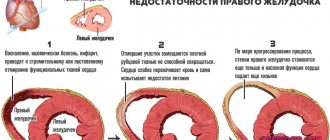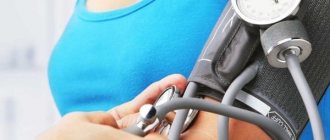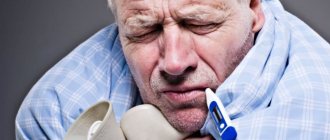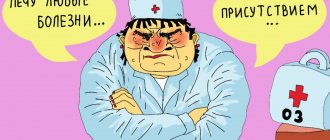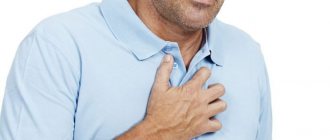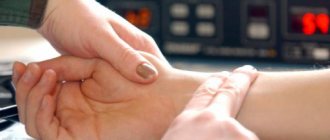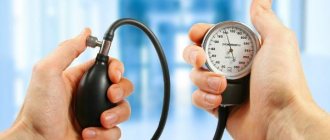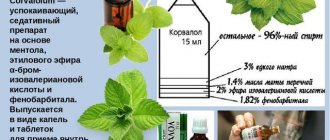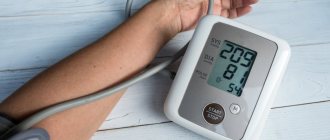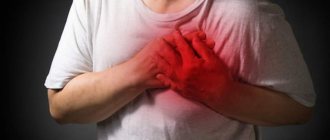Reasons for the increase
Increased heart rate is often accompanied by unpleasant sensations. Tachycardia can be determined not only by counting the pulse, but also by other complaints. In addition, with ventricular tachycardia, the pulse does not change; the presence of the disease can only be determined using additional diagnostic methods. You can suspect the presence of tachycardia based on special signs:
- The patient complains of a feeling of strong palpitations (as if the heart is jumping out of the chest), lack of air.
- With paroxysmal tachycardia, palpitations occur suddenly. The pulse can increase to 200 beats per minute.
- Sometimes it is impossible to count the pulse.
- During an attack, patients complain of heart fluttering and fear of death.
- The patient becomes pale, the face is covered with cold sweat.
- With atrioventricular paroxysmal tachycardia, pulsation of the veins in the neck is clearly visible.
- Ventricular tachycardia is characterized by a rare venous pulse and rapid arterial pulse.
The frequency and duration of the attack depends on the cause. It even happens that it does not go away for several days.
If tachycardia occurs, if it is not caused by physical activity or excessive consumption of products containing caffeine, you should immediately consult a doctor. After all, an increase in heart rate can be caused by various factors. And in order to cure tachycardia, it is necessary to identify the true cause of its occurrence.
The pulse accelerates not only with heart disease, but also with:
- hyperthyroidism;
- acute vascular insufficiency;
- anemia;
- intoxication;
- respiratory failure.
It happens that the heartbeat increases even with a common cold, accompanied by an increase in body temperature.
In addition, tachycardia signals the presence of the following heart diseases:
- myocardial infarction;
- unstable angina;
- chronic heart failure;
- acute myocarditis;
- myocardiopathy.
Whatever the reason, it is necessary to restore normal heart rhythm as soon as possible. Indeed, with tachycardia, the heart works beyond its capabilities, which leads to the occurrence of serious pathologies.
It is important to know! If tachycardia is caused by psycho-emotional stress, you should definitely consult a doctor so that he can prescribe appropriate treatment. After all, stress, especially long-term stress, provokes the development of deadly diseases such as heart attack, stroke, etc.
An increase in heart rate to 180 - 200 per minute is always a serious threat to health.
An increase in heart rate (HR) and pulse up to 180 - 200 per minute, if we consider it as an electrical process in the heart, can have different origins. The diagnosis and treatment methods depend on the nature of the rapid pulse. Therefore, some patients with such palpitations will be suitable for certain techniques and medications, while others will be suitable for completely different ones.
So, a pulse of 180 per minute can occur as a result of the following processes occurring in the heart:
- Severe sinus tachycardia.
- Supraventricular or supraventricular tachycardia.
- Atrial flutter.
- Paroxysmal ventricular tachycardia.
Thus, if a pulse of 180–200 occurs in a young man during intense exercise, it must be stopped and wait for the heart rate to normalize. In all other cases, urgent medical attention is required.
Such indicators can occasionally develop in young people 20–30 years old during intense exercise, for example, running. This cannot be allowed.
During physical activity and running, it is necessary to keep your heart rate much lower so as not to deplete the heart muscle. After stopping the load, the pulse in such people quickly slows down to normal values (recovery times vary from person to person, usually ranging from 3 to 10 minutes).
Supraventricular or supraventricular tachycardia - this condition is already a pathology. With it, signals for heart contractions are formed in one of its upper chambers (atria) and, due to anomalies in the structure of the conduction pathways, cause an attack of rapid heartbeat with a frequency of more than 140 per minute. Such a paroxysm can even last for several hours or days and requires immediate medical attention. In young people and children, a pulse of 180 per minute is often a manifestation of tachycardia in Wolff-Parkinson-White syndrome.
Drug therapy
Elimination of symptoms of high heart rate is necessary in parallel with treatment of the underlying disease. Therefore, only gentle symptomatic therapy is used. First of all, you should stop using drugs that increase heart rate - adrenaline, ephedrine, caffeine and some other drugs. Sedative medications should be prescribed - Corvalol, Valocardine, tincture of valerian or motherwort and similar ones. It is necessary to avoid the consumption of alcohol and caffeinated drinks (coffee, energy drinks, strong tea). Nicotine has a very harmful effect.
Among stronger medications (as prescribed by a doctor), beta blockers and cardiac glycoside (digoxin, isolanide, etc.) can be used. Anaprilin is usually used as a blocker (3 times a day, starting with a dose of 5 mg). If the body has a contraindication to such drugs, then falipamine or anilidine tablets should be taken.
It is recommended to optimize nutrition: limit the consumption of salty, fatty and spicy foods. Marinades and canned food should not be included in the menu. Light physical activity in the fresh air and therapeutic cardiological exercise are very useful.
A high pulse is not an independent disease, but is very often a sign of illness. If tachycardia persists for a long time, the question of what to do should be discussed with a doctor.
1poserdcu.ru
December 22, 2014.
Most likely, most of the time we do not notice the incessant activity of our heart: but we are talking about almost 100 thousand beats per day, or about 37 million per year, or an average of 3 billion heartbeats during a human life.
But this doesn't always happen. Sometimes we still feel our heartbeat. Sometimes the pulse may suddenly speed up for no apparent reason. Or the heart begins to flutter, it may even seem that the pulse disappears. And then we think: is this normal?
This question is quite complicated, especially for people who are far from cardiology. Therefore, we propose to get acquainted with the most common myths about heart rate (HR). And find out the truth about each of them.
Myth #1: An intermittent heart rate means you're having a heart attack.
This rarely happens. If we observe the heart rate of any person for a long enough time, we will find that almost everyone's pulse sometimes stops or the heart makes extra beats. Very rarely, these sensations (not accompanied by chest pain or shortness of breath!) mean a heart attack. If you feel something like this for the first time or with enviable consistency, then perhaps this is a consequence of a pathology such as heart rhythm disturbance (arrhythmia).
Despite the fact that most heart rhythm disturbances are benign, they should not be left to chance. Some arrhythmias are known to increase the risk of stroke, heart failure, and sudden death. Therefore, it is necessary to inform your doctor about any problems with the pulse , even if at the time of communication with the doctor there are no annoying symptoms.
Arrhythmia can disrupt the functioning of the upper chambers of the heart (atria) or - which is more dangerous, but much less common - the lower chambers (ventricles). Atrial fibrillation (AF) is the most common atrial arrhythmia, in which the heart beats irregularly and becomes more noticeable. AF often causes a rapid heartbeat, but a slow heart rate or even a normal heart rate can also occur with this condition. An electrocardiogram is one way to detect AF.
Myth #2: A high heart rate is a sign of stress.
Increased heart rate at rest is tachycardia, in which the heart rate reaches 100 or more beats per minute. It can be caused not only by stress, but also by a number of other reasons: smoking, consuming large amounts of caffeine, dehydration, high fever, anemia, and thyroid diseases. If you have tachycardia at rest (more than 85 beats per minute) without an adequate reason, be sure to consult with your doctor so as not to miss the onset of any heart disease.
With tachycardia with a very rapid pulse, from 200 beats per minute or more, a person experiences shortness of breath, chest pain, dizziness and fainting. Prolonged tachycardia with a heart rate of 130 beats per minute or higher can cause weakening of cardiac function. But there is a chance to solve this problem if you return the pulse to normal. Typically, tachycardia is treated with medication or electrical impulse therapy, in which the rhythm is restored using an electrical discharge. In some cases, limited destruction of the tiny areas of heart tissue causing the arrhythmia is used to normalize the heart rate.
Myth #3: A normal resting heart rate is between 60 and 100 beats per minute.
This is actually the normal heart rate range for adults, but heart rates at the higher end of this range can lead to serious health problems. This heart rate, according to some studies, is associated with an increased risk of coronary heart disease, stroke and sudden cardiac arrest. For example, Norwegian researchers found that for every 10 beats of increase in resting heart rate, the risk of death from a heart attack increases by 18% in women and 10% in men. And Japanese scientists recently determined that a heart rate of more than 80 beats per minute is associated with a greater risk of developing obesity or heart disease that will appear decades later. Let us remember that diabetes and excess weight contribute to the development of heart disease.
What is the maximum maximum resting heart rate? There is no absolute consensus among cardiologists around the world on this issue, but most doctors believe that it is best to avoid the upper end of the normal range. Typically, a heart rate of 90 beats per minute or higher is considered abnormal and potentially dangerous.
To determine your resting pulse, apply gentle pressure with your index and middle fingers to the area of your wrist that is slightly below your thumb. When you feel the pulse, count the heartbeats for 1 minute (you can count for 30 seconds, and then multiply the resulting number by 2). To ensure an accurate result, you should sit quietly for at least 10 minutes before taking your pulse.
Myth No. 4: A slow pulse is a sign of a diseased heart.
People often think that if their pulse is too slow, their heart may stop. In fact, it's just the opposite.
The heart is a muscle, and like all other muscles, it becomes stronger through exercise. The more developed the heart muscle is, the more efficiently it works, pumping blood throughout the body with fewer contractions. This is why well-trained athletes often have a resting heart rate of 40–60 beats per minute, and this is considered normal for them.
It should be noted that a low heart rate in young people without any other symptoms is not a cause for concern. In older people, a resting heart rate below 60 beats per minute (bradycardia), even in the absence of other symptoms, may indicate the presence of some kind of heart pathology. Some heart medications, including beta blockers, can cause bradycardia, accompanied by fatigue, dizziness, and fainting.
Myth No. 5: If your heart rate is normal, your blood pressure should also be normal.
There is no connection between pulse and blood pressure (BP). A person can have a normal resting pulse and high blood pressure at the same time and vice versa. For example, during heavy physical exertion or extreme psycho-emotional stress, the heart rate sharply increases, while at the same time blood pressure may increase slightly.
Bottom line: Heart rate and blood pressure are two different things. The only way to find out your blood pressure is to measure it with a tonometer.
walkwithadoc.ru
What to do if your heart rate is 100-200 beats per minute?
It happens that a person experiences an illness that is not considered fatal, but causes him some discomfort. One of these unpleasant moments is tachycardia (excessive heartbeat). Anyone can encounter manifestations of tachycardia. That is why people need to know what reasons could cause the painful condition and how to act so that the pulse returns to normal levels.
In the medical literature, tachycardia refers to a special type of arrhythmia in which the heart rate exceeds ninety beats per minute.
Tachycardia interferes with the normal functioning of the cardiovascular system, since the heart, which beats too quickly, does not have time to fill with blood to the required extent. This means that the blood supply to vital systems and organs is deteriorating.
According to its etiology, tachycardia can be:
- physiological (the body’s normal reaction to climate change, fear, conflict situations, nervous tension, physical activity);
- pathological (a dangerous condition associated with a malfunction of the heart and other internal organs).
The main symptoms of tachycardia:
- The patient feels his heartbeat (in a normal state the person does not notice it);
- Dizziness;
- Increased pulsation of blood vessels in the cervical spine.
There are many reasons for the appearance of tachycardia. It is customary to divide the factors for the development of tachycardia into two groups: internal and external.
Internal (cardiac or intracardiac) causes:
- cardiac ischemia;
- heart disease;
- myocardial infarction;
- acute vascular insufficiency (can occur with fainting or shock, as a result of loss of a large amount of blood);
- cardiosclerosis;
- other congenital or acquired pathologies of the heart muscle.
External (extracardiac or extracardiac) causes:
- mental disorders;
- disturbances in the functioning of the endocrine system (for example, with thyrotoxicosis);
- a sharp change in body position (the person was lying and quickly stood up, squatting and suddenly straightened up);
- dehydration of the body;
- anemia;
- strong emotional experiences and associated stress;
- drinking strong tea, coffee, energy drinks;
- bites of spiders, wasps, bees, snakes;
- high body temperature (for example, with sunstroke or acute infectious diseases);
- the use of certain medications (hormonal, psychotropic drugs or drugs whose task is to activate the nervous system).
For successful treatment, it is necessary to carefully examine the patient in order to accurately determine the causes of rapid heartbeat. The doctor may recommend an ultrasound of the heart or coronary angiography. Mandatory tests include an electrocardiogram and a blood test (general, biochemical). A thyroid hormone test is required.
Anyone should be able to provide first aid for tachycardia. To normalize the number of heartbeats, there are simple but effective techniques. They can be used independently and at home.
Simple tips to reduce your heart rate:
- 1. wash your hands and face with cold water;
- 2. tense all the muscles and then relax them (repeat this several times);
- 3. cough, as if clearing your throat;
- 4. close your eyes and lightly massage your eyeballs;
- 5. breathing exercises (you need to hold your breath, and then exhale with effort, do the exercise for about five minutes).
If the cause of heart rhythm disturbances is neurological disorders, medications that calm the nervous system are prescribed. Popular products include Tenoten, Persen, valerian tinctures, and Zelenin drops. If there are mental disorders, then you cannot do without antipsychotics.
Promazine or Levomepromazine are often used. A recognized remedy for eliminating arrhythmia is Lidocaine (administered in the form of droppers or injections). A course of peony tincture has a good therapeutic effect. Valocordin has had some success in reducing heart rate. You can successfully stop a spasm with the help of validol.
Important! The use of all medications is possible only under the supervision of a physician!
To avoid heart palpitations, you need to follow simple rules:
- stop smoking, because it provokes vasospasm;
- If possible, stop drinking alcohol and energy drinks;
- Healthy food;
- It is impossible to avoid conflict situations, but it is within the power of any person to learn to relax and reduce the significance of stressful situations for themselves;
- correctly alternate work and rest, perform feasible physical exercises.
tachycardia what to do
Attacks of rapid heartbeat in medicine are called paroxysmal tachycardia. Such attacks usually begin and end spontaneously and last from a few seconds to several hours. With palpitations, the heart rate reaches more than 200 beats per minute, while the norm for an adult is 60-70 beats.
Many experts consider attacks of rapid heartbeat to be a natural phenomenon. For example, the heart rate increases due to physical activity and emotional experiences. Such tachycardia quickly passes without medical attention. In addition, palpitations accompany an increase in body temperature.
If palpitations appear at rest and at normal body temperature, you should consult a cardiologist. An attack of tachycardia may be a sign of acute heart failure, myocarditis, intoxication, an infectious disease, and so on.
During attacks of rapid heartbeat, a focus of excitation occurs in some part of the cardiovascular system, provoking electrical impulses of high frequency. Depending on the location of the source of excitation, paroxysmal tachycardia is of two types:
– Atrial (occurred in the cells of the atrium);
– Ventricular (occurred in the cells of the ventricles).
Atrial tachycardia causes a rapid heartbeat, in which the heart rate reaches 180-260 beats per minute. Such attacks of palpitations are caused by oxygen starvation of the heart muscle, endocrine disorders, and disturbances in the amount of electrolytes in the blood. With this disease, along with a rapid heartbeat, chest pain, shortness of breath, dizziness and general weakness appear. In case of disorders of the autonomic nervous system, these symptoms may include increased blood pressure, chills, excessive and frequent urination, a feeling of lack of air, and a feeling of a lump in the throat.
Ventricular tachycardia is characterized by a heart rate of 140-200 beats per minute. In this case, an attack of rapid heartbeat is accompanied by dizziness, weakness, pallor, blue lips, shortness of breath, and cough. The causes of ventricular tachycardia lie in heart diseases: acute or chronic coronary heart disease, cardiomyopathy, inflammatory diseases of the heart muscles, heart defects. In addition, ventricular tachycardia may indicate an overdose of cardiac glycosides. Such rapid heartbeat can be dangerous, as it often leads to ventricular fibrillation, in which not the entire ventricular muscle contracts, but its individual fibers in an erratic rhythm. This causes serious circulatory problems and pulmonary edema.
Diagnosis of attacks of rapid heartbeat is carried out by listening to the heartbeat, as well as by analyzing the electrocardiogram. If the palpitations are short-lived, then a daily electrocardiogram is necessary.
Treatment of attacks of rapid heartbeat
The following methods are effective for palpitations:
– Valsalva maneuver – tensing the abdominal muscles and limbs for 15 seconds at intervals of 1-2 minutes.
– Hold your breath for 10 seconds during the deep inspiration phase;
– Sharp narrowing of the eyes helps slow the pulse;
– Attacks of rapid heartbeat are relieved by coughing or gag reflex;
– Chermik-Goering test – massage of the carotid sinus (the branching area of the common carotid artery in the neck);
– Medicinal methods, including taking Corvalol, Valocordin, etacizin and other drugs.
– Electropulse therapy is used if previous methods have failed.
If an attack of rapid heartbeat occurs for the first time in a patient, and the rhythm does not return to normal for a long time, an urgent consultation with a cardiologist is necessary. At the Grand Elizabeth Medical Center, consultations are conducted by an experienced cardiologist. You can make an appointment for a consultation by calling the numbers listed on the website.
Tachycardia Treatment of tachycardia with folk remedies
loading.
What is tachycardia? Many of us, at least once in our lives, have experienced a condition in which the heart beats very quickly, like a “hare’s.” Such rapid heartbeat, sometimes accompanied by weakness and pain in the heart, is called tachycardia. Tachycardia refers to one of the types of arrhythmias - disturbances in the frequency and sequence of the rhythm of heart contractions.
Arrhythmia can be caused by a variety of reasons. Tachycardia is often caused by stress, coffee, alcohol or excessive exercise. Tachycardia can signal diseases of the cardiovascular system (ischemia, heart defects, hypertension, myocarditis), diseases caused by infections, diseases of the thyroid gland, menopausal changes in the body. Arrhythmia is common in pregnant women.
How can I help you? First of all, you need to reduce physical activity and reduce caffeine consumption. Quit smoking, eliminate alcohol and be less nervous. Adjust your daily diet. Eat less fatty and spicy foods. A vegetarian diet and drinking vegetable and fruit juices are very helpful. More moderate physical activity, for example, walking, doing breathing exercises.
Treatment of tachycardia with traditional medicine.
Tachycardia should be treated based on the reasons that caused it. The following methods will help with first aid for palpitations: you need to take a couple of breaths, close your eyes and press hard on the eyeballs, apply a cold compress to your neck or dip your face in cold water.
If arrhythmia is caused by stress, it is useful to take soothing herbal teas and herbs. Brew tea with mint and lemon balm. It is useful to drink tincture of valerian, motherwort, and hawthorn.
In alternative medicine, there are many methods and recipes for treating tachycardia.
A decoction of chamomile inflorescences, valerian root and mint, 30g each, helps treat tachycardia. Pour about 5-6 g of the mixture into 200 ml of boiling water, leave and drink half or a quarter glass hot several times a day. This collection reduces tachycardia and is sedative.
To get rid of tachycardia using traditional medicine, we also use this mixture of horsetail - 2 parts, hawthorn flowers - 5 parts, knotweed - 3 parts. Pour 5 g (a tablespoon) of this mixture into a glass of hot water, let it brew and strain. Take a third of a glass orally 3-4 times a day for palpitations and insomnia.
This collection also contributes to healing - take peppermint leaves and watch leaves 20 g each, valerian root and hop cones 10 g each. Brew this mixture (a tablespoon) with a glass of boiling water, let stand for 15-20 minutes, strain. Drink 100 ml decoction 2 times a day.
For frequent heartbeats, using fresh honeysuckle berries or tea with berry jam will help. Less commonly used is a tincture of berries. A tincture of the roots and bark of red elderberry is used.
Tachycardia can also be cured with plants that grow in our garden or with products that are very easy to find.
Honey and other bee products help dilate heart vessels and improve blood supply to the heart. For example, mix 1 teaspoon of bee bread with half a glass of honey and consume 1-2 teaspoons 2-3 times a day. Beet juice, mixed half and half with honey, half a glass 3-4 times a day, is recommended as a sedative and for tachycardia caused by high blood pressure.
For tachycardia, folk medicine recommends a decoction of buckwheat inflorescences in combination with marsh cudweed (toad grass). Take the herb of these plants one tablespoon at a time and brew 200 ml of boiling water.
If you follow the recipes, traditional medicine and method of application correctly, you can cure tachycardia.
To find out whether rapid heartbeat is the result of primary tachycardia, you need to consult a cardiologist, do an electrocardiogram of the heart, undergo echo monitoring, ultrasound of the heart and thyroid gland, and take blood tests for hormones. If all indicators give a negative result, then we are talking about secondary tachycardia.
Again, if, with a rapid heartbeat, after taking sedatives and sitting quietly for 15 minutes with your torso elevated and legs down, the pulse does not recover to 80-90 beats per minute, you must call an ambulance, and subsequently undergo a detailed examination of other organs.
In addition, tachycardia occurs with anemia, due to a decrease in hemoglobin in the blood. Reduced hemoglobin reduces blood supply to tissues, and the heart muscle has to contract faster to deliver the required amount of oxygen to the entire body. It is recommended to take iron supplements, ascorbic acid, and a diet rich in vitamins.
Tachycardia often occurs in adolescents during the period of their active growth and development, when cardiac function simply does not keep up with growth. Over time, the process returns to normal.
Tachycardia at elevated temperatures also does not require drug treatment; an increase in heart rate by 10 beats when the temperature rises by one degree is considered normal. When the temperature drops, the pulse normalizes. If the heartbeat is excessively bothersome, you can take a valerian extract tablet or Corvalol.
Secondary tachycardia is treated with medications and sedative herbs, as well as antidepressants. The most effective herbs, such as mint, lemon balm, valerian, rose hips, are taken as tea for a long time (3-5 months).
An increase in heart rate is often observed when taking certain cardiovascular drugs - Trental, Mildronate, Euphilin, Teopeca. It is believed that this is the “first dose effect,” the body’s reaction to a new drug. With long-term use, these side effects usually disappear.
Since paroxysmal tachycardia is a manifestation of organic damage to the heart, it is necessary to treat the diseases that caused the rapid heartbeat, but not to eliminate it.
Regular stress and exhausting physical work, causing secondary tachycardia with a pulse of more than 120 beats per minute, can lead to such a serious myocardial disease as atrial fibrillation. You shouldn’t bring your body to this state; you need to learn to control your emotions, which will significantly prolong your life.
ponakad.wordpress.com
Treatment with medications
There are many antiarrhythmic drugs, but it is not advisable to use them on your own at home. Medicines have different principles of action, the effectiveness of the medicine depends on the cause of the disease.
If you experience increased heartbeat, regardless of physical activity, or consumption of foods that cause increased heart rate, you should call an ambulance. Until the doctors arrive, you should take the following measures yourself:
- Lie down and try to calm down. Try not to listen to how your heart is beating, start thinking about something pleasant. Anxiety and worry, worries about when the doctor will finally arrive will lead to a deterioration in your health.
- Drink warm tea with lemon balm, motherwort and valerian, if you are not allergic to these herbs.
- Validol will help to urgently relieve heart pain and tachycardia. The tablet must be placed under the tongue, so it will act faster and more effectively. You can use nitroglycerin instead of validol if there are no contraindications.
- 30 drops of Corvalol, valocormid or valocardine can not only reduce the heart rate, but also dilate blood vessels. Such measures will help prevent the occurrence of stroke or myocardial infarction.
You can calm your heartbeat using reflex treatment methods aimed at increasing the tone of the vagus nerve:
- hold your breath with straining at the height of inspiration for 5-10 seconds;
- apply moderate pressure with your thumbs for 5 seconds on the eyes under the supraorbital arches;
- Immerse your face in cold water and hold your breath for 20 seconds.
If medication and reflex treatment do not help, then electrical defibrillation is performed.
After conducting an examination and determining the cause of tachycardia, the doctor prescribes a therapeutic course. If the disease is not severe, then treatment can be carried out at home.
What to do if your heart rate is high
When your heart rate increases, it is important to carefully analyze the situation. Firstly, is this manifestation caused by any of the above temporary factors. If this is not the case, it is worth measuring the pressure. High blood pressure is often accompanied by an increased heart rate. If the pressure is normal and all factors associated with the failure are excluded, it is worth considering more serious causes.
Procedure for elevated heart rate:
First, take a deep breath and try to calm down. Sit down, drink a glass of water. After approximately 15 minutes, measure again. If he returns to normal, then there is nothing to worry about.
If the high pulse persists, but you feel quite normal, you can take soothing drops (for example, motherwort, Corvalol, etc.) and lie down. Open a window and focus on deep, even breathing. Just in case, measure your blood pressure (if you have a tonometer): perhaps the whole point is to increase it.
If, in addition to a high pulse, there are symptoms such as fever, pain in the abdominal cavity or heart area, dizziness, etc., you must urgently call an ambulance. Wait for her arrival lying on the bed, do not take any medications yourself.
Try a few exercises that should help lower your heart rate:
- inhale deeply, exhale with tension (cough when exiting);
- Gently knead the sides of the neck, where the large arteries are located;
- lightly press on the hole located on the inside of the left arm in the area of the hand and hold it pressed for about a minute;
- apply light pressure to your eyeballs and hold your fingers on them for about 30 seconds.
How to get rid of tachycardia
When treating tachycardia at home, taking medications prescribed by a doctor is mandatory. In addition, you can use traditional medicine methods:
- Drink 100 g of calendula infusion 4 times a day. To prepare it, 2 tsp. pour 500 ml of boiling water over the flowers and leave in a warm place for 2 hours.
- Tea from a collection of herbs. 1 tbsp. pour a glass of boiling water into a spoonful of a crushed mixture of yarrow herb, hop cones, valerian root, and lemon balm leaves in a ratio of 2:2:3:3. Drink no more than 50 g 4 times a day.
- An infusion of blue cornflower flowers will help relieve heart palpitations.
Before using herbal medicine to treat tachycardia, you should consult your doctor.
In addition to taking herbs, you must follow a special diet. Products containing caffeine should be excluded from the diet. For palpitations, it is recommended to eat figs in any form. You can eat everything, but little by little and often (5-6 times a day), since an overfilled stomach stimulates the vagus nerve, which leads to depression of the sinus node and the appearance of arrhythmias.
Patients with tachycardia should avoid physical activity. The concept of heaviness is contraindicated. This load increases blood pressure and activates the heart. Walking in the fresh air will be useful. It is advisable to walk about 2 kilometers per day. You should be in the fresh air for at least 1 hour a day.
It is important to know! If you do not follow the doctor’s recommendations, then tachycardia will have to be treated surgically.
What to do if your heart rate is 100-200 beats per minute?
This is the frequency of oscillations of the arterial walls, determined by the heart rhythm. Reflects the number of heart beats over a period of time. It is a key indicator of the functioning of the heart and related human systems. To the seemingly simple question of how many beats per minute the heart should beat, many will give the wrong answer.
There is no definite answer, since even in a practically healthy person this indicator changes significantly under different conditions.
Still, there are some norms, deviation from which indicates the presence of serious pathologies of the body.
Most of them are related to the cardiovascular system.
It is believed that an adult's heart rate should be 70 beats per minute. In fact, this value changes at different periods of life.
In newly born children, the norm is 130 heart beats per minute. By the end of the first year of life, the pulse drops to 100 beats. The student should have about 90 strokes. In old age, the norm is 60 beats per minute.
There is a primitive, but generally quite reliable way to calculate the normal heart rate for a healthy person. It is necessary to subtract the number of years lived from 180. The resulting figure determines the normal indicator of this individual. Ideally. At absolute rest, without external irritants and normal atmospheric conditions.
In practice, this indicator in a healthy body can differ significantly depending on a number of factors. In the morning, as a rule, heart beats are less frequent than in the evening. And a person lying down has a slower heartbeat than when he is standing.
The accuracy of measurements will definitely be affected by:
- prolonged exposure of people to cold, hot sun or near heat sources;
- dense, fatty foods;
- consumption of tobacco and alcohol-containing drinks;
- sexual intercourse;
- taking a relaxing bath or massage;
- fasting or dieting;
- critical days for women;
- physical exercise.
To correctly track the parameters, it is necessary to measure the value of heartbeats for several days in a row.
Moreover, do this at different times, recording the results and conditions under which the measurement was carried out. Only this method will give a correct idea of the state of the cardiovascular system.
Enter your pressure
Accordingly, with age, heart rate decreases in intensity and the pulse slows down. The highest interval between indicators is in adolescents 12-15 years old, which is associated with the restructuring of the body, internal changes and maturation. Only a doctor can take measures to eliminate high rates and determine the exact causes of the disease after an examination.
The exact value of the norm when jogging is individual for each person; it is determined based on the physical fitness and well-being of the runner during training. To find out your norm, you will definitely need a heart rate monitor - a device that will count your heart rate while running. If you can maintain the required running pace, as well as control correct, even breathing through your nose, and at the same time feel great, then your heart rate will be the norm for training.
Depending on the intensity of the load, running workouts are divided into 3 categories:
- Jogging. The maximum permissible heart rate is from 130 to 150 beats per minute, the running duration is from 20 to 40 minutes.
- Middle and long distance running. The pulse should not exceed 150-170 beats per minute, the duration of the race is from 10 to 20 minutes.
- Acceleration run. The maximum permissible heart rate is from 170 to 190 beats per minute, the running duration is from 5 to 10 minutes.
These indicators are averaged, and to find out the exact rate of your heart rate, you need to use a special formula.
For men under 30 years of age, the running formula will look like this: 220 – x, where 220 is the maximum allowable heart rate, and x is the age in years. Formula for calculating maximum heart rate when running for women: 196 – x.
For example, for a 25-year-old man, the heart rate while running should not increase to more than 195 beats per minute (220-25 = 195).
By measuring your heart rate while running with a heart rate monitor, you can find out your normal rate. This will be a heart rate at which you can run freely for the entire specified time, while maintaining the desired running speed and proper breathing. In this case, the pulse should not exceed the permissible maximum values calculated by the formula.
When your heart rate begins to exceed the maximum allowed for the selected category while running, you should change from jogging to walking and calm your heart rate. Then start running again, while not forgetting to monitor your heart rate.
By training in this way, you do not create dangerous loads for your body, but, on the contrary, gradually strengthen it. With this running technique, the heart rate will eventually stop soaring sharply from running loads, but will increase smoothly and moderately, gradually allowing you to train longer and more intensely.
Heart rate monitoring
Measuring and monitoring heart rate while running can be done in two ways:
- Manual.
- Mechanical.
Manual method.
Before you start running, you press your fingers to your wrist or neck, find the pulsating artery and, looking at your watch, count the frequency of vibrations per minute. Then run, and after stopping, count the pulse beats again.
Mechanical method.
You can use a heart rate monitor to measure your heart rate. It is convenient because it fits tightly on your hand like a watch and reads your indicators. But such a device does not always show accurate results.
The best is considered to be the one that is worn on the arm above the elbow, and a special strap with a sensor is placed on the chest. Such devices are often used by athletes and swimmers to determine their heart rate during training.
We have selected 2 heart rate monitors for you that caught our attention among other options:
- Beurer PM18 heart rate monitor. Worn on the left wrist. With one touch of the device you can find out your pulse. The device also determines the distance traveled, calories burned, the number of steps taken and the amount of fat eliminated. It has a built-in alarm clock, stopwatch and calendar. This waterproof device is used by swimmers, so you can run with it even in rainy weather.
- Heart rate monitor Torneo H-102. One part of it is put on the arm, the second on the chest. At first it seems inconvenient, but almost all athletes use chest-mounted, more accurate, heart rate monitors to determine their heart rate. This device is equipped with a watch-receiver, reads your pulse, and determines your calorie consumption. It has an alarm clock, calendar and is waterproof.
What affects the pulse
The following factors can have a strong influence on the heart rate both when jogging and when the body is at rest:
- Overweight. People who are overweight may experience increased heart rate fluctuations above normal when running. It is enough to reduce the load (slow down the running pace), and the heart rate will normalize.
- Fitness level. When running, trained people's heart beats slower than that of an ordinary person. This is explained by the fact that the athlete’s heart has adapted to constant physical activity and contracts less frequently.
- Drinking alcohol and smoking. The heart of a person who drinks and smokes beats at an increased pace while running, which, naturally, is manifested by an increase in heart rate.
- Body and ambient temperature. In autumn, winter and spring, body temperature will naturally be lower, as will the pulse rate. But in the summer, the opposite happens: the temperature rises, the pulse accelerates. In terms of heart rate, summer jogging is compared to intense work in the gym.
- Nervous or tense state. While running, it is advisable not to think about the problems that surround us in everyday life. To ensure that the rhythm of your pulse beats does not jump and is even, it is advisable to think about your body, breathing, step size, and not about pressing problems. It is better to listen to music while running and not be distracted.
A high pulse when running indicates that the heart muscle has become more active in pumping blood through the veins, delivering oxygen to all organs, that is, the load on the heart has increased.
Rapid heartbeat: what to do
Attacks of rapid heartbeat are medically called tachycardia. There are two types of tachycardia - paroxysmal and sinus. Paroxysmal tachycardia is a very dangerous diagnosis; it indicates that there is a disorder of the cardiovascular system and organic damage to the heart.
Sinus tachycardia manifests itself during an emotional outburst or excessive physical activity, and sinus tachycardia also manifests itself in hot weather.
Read: Signs of a heart attack in women
Rapid heartbeat: what to do?
Attacks of tachycardia are spontaneous and can last from a few seconds to several hours. The normal pulse rate for an adult is 60-70 heart beats per minute; with tachycardia, the heart rate can be about 200 beats per minute. If you periodically experience tachycardia, you need to find out its nature, so you should definitely come to an appointment with a cardiologist, do an electrocardiogram, an echo scan of the heart, and take a blood test for hormones.
Read: Fluid in the pericardial cavity
The first remedy that can be used at home is to take any sedative; within 10-15 minutes the pulse should drop to normal 60-70 beats per minute. If you experience rapid heartbeat and shortness of breath, then you should take a sedative and take a horizontal position, your torso should be slightly elevated and your legs, on the contrary, lowered.
Shortage of air means that there is not enough hemoglobin in the body, which means that the tissues are not fully supplied with oxygen, and the heart has to pump more blood to supply the entire body with oxygen. Low hemoglobin is usually a sign of anemia. To support the body, doctors prescribe taking iron supplements, ascorbic acid, and vitamins. You should also review and change your diet.
Read: Diagnosis of acute myocardial infarction
Paroxysmal tachycardia is a very serious complex disease; it can be a harbinger of acute heart failure, general intoxication of the body, or an infectious disease. This type of tachycardia is divided into atrial and ventricular. In addition to the symptoms of rapid heartbeat, with atrial tachycardia, there is chest pain, shortness of breath, excessive urination, chills, and increased blood pressure. With atrial tachycardia, the heart rate can reach 260 beats per minute.
Ventricular tachycardia is accompanied by dizziness, weakness, pallor, shortness of breath, and cough. The causes of this type of tachycardia are heart diseases, such as heart disease, coronary heart disease, inflammation of the heart sac and heart muscle. A very dangerous type of tachycardia, in which pulmonary edema and circulatory disorders develop. If these symptoms occur, you need to urgently call an ambulance.
What to do and how to help yourself if your heart rate increases rapidly?
Try self-massage of the branching area of the common carotid artery in the neck, the so-called carotid sinus, sharply closing the eyes - this method allows you to slow down the pulse, hold your breath for 10 seconds, tense the abdominal and leg muscles for 15 seconds. Among the medications you can take Corvalol, Corvaltab, Valocordin, valerian.
cutw.ru
When is your heart rate considered high?
A high pulse is a pulse whose frequency is above 90 beats per minute. in a calm state. When the heartbeat is more than 100 beats/min. Doctors diagnose tachycardia. In this case, as a rule, the interval between contractions of the heart muscle is stable. A temporary increase in heart rate (no more than 30 minutes) can be caused by a stress factor or physical activity.
After a short time it is restored. Accordingly, if the patient’s heartbeat exceeds 90 beats/min for a long time, even with normal pressure, there is a pathology of the cardiovascular system. There are individual heart rate norms that depend on age, gender, health and weight.
What to do during attacks of tachycardia?
Tachycordia is an increase in heart rate.
The heart muscle of a healthy adult at rest contracts 50-100 times per minute. For children, the norm is higher and depends on the age of the child. For a newborn, this is 120-140 contractions per minute. Gradually, by 5-6 years of age, the heart rate decreases to 90. For older people with poor health, 90-100 beats per minute are acceptable. For athletes, 40-60 beats per minute will be the norm. If the heart rate is more than 100 per minute, we can talk about the occurrence of tachycardia.
Its causes and types are varied. An attack of tachycardia can be physiological and pathological.
How to determine pulse correctly
Most specialists measure the pulse at the wrist artery. This is due to the fact that the wrist artery passes close to the surface of the skin. In the marked place it is very convenient to independently detect and count the pulse. You can even do this for yourself.
The artery is felt on the left arm, since it is closer to the heart, and therefore the shocks of the artery walls are more distinct. You can measure the pulse on your right hand. It is only necessary to take into account that in this case it may be felt out of sync with the heartbeats and be weaker.
Ideally, the pulse in both arms should be the same for an adult. In practice, it varies. If the difference is large enough, then the cause may be problems with the cardiovascular system. If this is discovered, then it is necessary to undergo examination by a specialist.
In order to correctly count the pulse, you need to turn your left palm up. It is better to place your hand on a horizontal plane at chest level and bend your wrist slightly.
If you grab your wrist from below with your right hand, the middle finger of your right hand will feel shocks in the area of the bend of the wrist of your left hand. This is the radial artery. It feels like a soft tube. You need to press it lightly, which will allow you to better feel the shocks. Then count the number of pulsations for a minute.
This will be the pulse. Some people count their pulse for 10 seconds and then multiply it by six. We do not recommend this method, since when counting beats per second, the error increases, which can reach large values.
It is not recommended to determine the pulse using your thumb, as it is less sensitive. You can miss the impulse from the heartbeat, which also leads to errors in the calculations.
Heart rate monitoring
Manual method.
What affects the pulse
High pulse: concept, characteristics
High pulse, or tachycardia as it is called, is a heart rate value exceeding 100 beats per minute. In this case, the heart muscle experiences overload, and the functioning of the cardiovascular system begins to malfunction.
To understand the features of the formation of heart rate and the causes of deviations from normal indicators, it is necessary to understand the features of the concept itself. In medicine, the pulse is characterized as a rather “multi-layered” concept, consisting of many characteristics:
- Rhythm of heart beats. Refers to the frequency of heartbeats felt on the artery wall. When a malfunction occurs in the cardiovascular system, this indicator is the first to deviate from the norm.
- The “Filling” parameter shows how much it can be felt on the hand. If this indicator is very weak, we can confidently speak about an insufficient volume of blood released by the heart during one contraction. Also, weak filling may indicate heart failure.
- “Tension” characterizes the force of compression of the artery so that it can be felt. The higher the blood pressure, the stronger the pulse will be felt (sometimes just touching the skin with your fingertips is enough).
- Height. A characteristic that is quite difficult to determine tactilely (most often only specialists can do this). The height of the pulse refers to the degree of oscillation of the arterial wall during measurement.
- Frequency is an indicator that is used to characterize the pulse more often than others. Refers to the number of heart beats per minute. It is usually felt on the wrist or on other large arteries (for example, in the neck).
When talking about a high heart rate, it is the latter indicator that is most often meant.
Pulse 120: is it dangerous?
It is necessary to stabilize the pulse rate; an accelerated rhythm can cause a stroke.
Tachycardia, when the pulse is above 100 beats per minute, may indicate pathology, illness or inflammatory processes in the body. Treatment in such a situation is necessary. Ignoring this pathology can impair cerebral circulation and become a harbinger of a stroke. Often, tachycardia contributes to the development of ventricular failure.
The reasons for an increase in heart rate may be different. Often, a high rhythm becomes not a problem, but a symptom of internal pathologies, indicating invasion, poisoning or inflammation. An increase in heart rate is provoked by overwork, lack of sleep, depression, fatigue, synthetic drugs and lack of vitamins. By its nature, tachycardia has 2 different types. Below is a table describing them.
It takes a short period of rapid heartbeat (up to 15 minutes). The reason for its appearance is physiological stress, stress, tension. After a quarter of an hour it returns to normal levels. No treatment applied
Lasts over 15 minutes. May occur with systematic frequency. Appears as a result of purulent diseases, infections, problems in the endocrine system or heart and lung diseases. It is necessary to take medications to restore the functioning of the cardiovascular system.
Depending on the nature of the acceleration, the beats can become systemic. This situation (pulse - 120 beats per minute) can be provoked by hardening of the artery, constant stress, and impaired thyroid function. With improper metabolism, the heart works more intensely. The work of the heart muscle is also negatively affected by emphysema, fatty and unhealthy foods, and overheating of the body.
Causes of high heart rate and potential dangers
Since the pulse characterizes the work of the heart muscle, it is limited to certain values. Exceeding them will indicate disruptions in the cardiovascular system. The average rate is about 60-90 beats per minute (in children - slightly higher).
The method of measuring the pulse and the time at which this process is carried out also play a significant role. For example, in the evening it is always a little higher. This must be taken into account. Also, in a lying position, the heart rate is always lower (than, for example, standing or sitting).
When to think
It is worth noting that when working intensively or visiting the gym in a healthy person, the normal heart rate increases significantly. So, when walking, the norm is 100 pushes per minute. A runner's heart rate can rise to 150 beats.
A person's pulse is considered dangerous when it approaches 200 beats per minute. In this state, it is necessary to stop physical exercise and give the body rest. In a healthy person, after 5 minutes of rest, the pulse returns to normal. If this does not happen, then this fact is evidence of problems with the heart or other body systems.
Another dangerous symptom is when, when climbing several floors of stairs, the heartbeat exceeds 100 beats per minute.
Timely detection of deviations from the norm can prevent serious complications, since this circumstance signals the presence of pathologies in the functioning of the body. Thus, with an accelerated heartbeat, which for a long time exceeds 100 beats per minute, serves as the main parameter of tachycardia. This is a dangerous disease that requires special treatment.
In this case, an increase in heart rate is possible around the clock, even at night.
If the number of heart beats per minute has decreased to 50, this indicates the presence of an equally serious disease - bradycardia. This is a very alarming condition that can manifest as sudden death even in adults. If these symptoms appear, the person should be taken to a specialist for examination.
Physiological tachycardia
As the name implies, this is a normal reaction of the body, a natural physiological process, and is not a disease. Rapid heartbeat can be caused by:
- Emotional experiences (grief, fear, joy);
- Any physical activity;
- Various environmental factors (stuffy room, staying at altitude);
- Increased body temperature (heartbeat increases by 10 beats when body temperature rises by 1 degree).
Hot flashes during menopause, banal overeating, and allergies can provoke an attack of tachycardia. The heart rate may increase with frequent consumption of strong coffee or tea, or energy drinks.
A distinctive feature of tachycardia in a healthy person is the absence of pain in the heart. Normally, after 2-5 minutes the pulse recovers on its own; no treatment is required. To determine the maximum allowable heart rate, subtract your age from 220. For example, a person is 60 years old. It is necessary from 220-60 = 160, which means that his pulse during exercise should not be more than 160 beats per minute.
What to do to lower your heart rate?
To lower your pulse, you can put a Validol tablet under your tongue, bend your head down and breathe in fresh air.
If the pulse is 120 beats/min. overtakes at rest and stays above 15 minutes. This means that measures need to be taken to reduce it. At the first stage, you need to call an ambulance. Before the doctors arrive, you can put Validol or Valocordin under your tongue without chewing or swallowing. To alleviate the condition, you can sit down, bend your head slightly and massage your neck.
Treatment of the disease
When treating tachycardia, blood pressure readings are initially measured, as they are interdependent. To quickly stabilize heart pressure, you can drink Metoprolol, Furosemide or Verapamil. If blood pressure is high, use “light” medications - valerian, motherwort, Valocordin or Corvalol.
In folk medicine, decoctions based on rose hips, motherwort, and valerian root are used. In addition to the recipe there is honey, which acts as a panacea for many diseases. These natural ingredients are brewed or infused in water. They are used for both prevention and treatment. But if the situation is chronic, then tachycardia must be treated with medications to avoid death.
Pulse measurement
The most common way to measure pulsation frequency is by palpation of the radial artery at the wrist, since in this area the artery is closest to the skin and is easily distinguishable.
The pulse is determined by directly counting the number of pulses, usually over 30 s (then doubling to convert to 1 min).
A more detailed picture for assessing the state of the cardiovascular system can be obtained by palpating the carotid and temporal arteries.
Sometimes impulses are checked in the subclavian, shoulder and femoral areas.
Attack of paroxysmal tachycardia
Patients describe an attack of paroxysmal tachycardia as a feeling of palpitations that began with a sharp push behind the sternum and, when the attack stopped, also abruptly ended. During an attack, they are frightened and exhibit motor restlessness. The jugular veins are swollen, with significant pulsations, synchronous with the arterial pulse. Only in the ventricular form of paroxysmal tachycardia can pulsation of the neck veins be observed in the rhythm of the sinus node.
Auscultation reveals an equalization of the intensity of the 1st and 2nd heart sounds, the pauses between the sounds become the same (“pendulum rhythm”). However, often the first sound can be increased due to a decrease in pressure in the ventricles of the heart. Often a gallop rhythm is established, which disappears after the attack stops.
- Pulse 64 beats per minute is normal
- Characteristics of pulse according to six indicators
